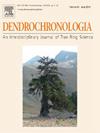Moderate effects of species mixing on the growth and drought response of Austrocedrus chilensis in northern Patagonia
IF 2.7
3区 农林科学
Q1 FORESTRY
引用次数: 0
Abstract
Accelerated climate warming, marked by rising temperatures and reduced precipitation, intensifies droughts, causing severe impacts on forest ecosystems. The mechanisms underlying the loss of tree vigor due to climate warming, are not fully understood. Overall, it appears that vigor loss is moderately controlled by regional climatic patterns and species admixture, as intra- and inter-specific interactions within a stand influence tree growth and drought performance. However, the role of the species mixing under climatic stress remains inconclusive. Here, we applied a dendroecological approach to assess growth trends, climatic responses, and drought performance in Austrocedrus chilensis trees growing under three species stand mixtures (pure, mixed, and diverse) in Patagonia, Argentina. Along the precipitation gradient, the general relationship between A. chilensis growth and moisture availability is driven by regional climatic conditions, while the response to individual extreme events is modulated by species mixing. We found that trees in mixed and diverse stands exhibited a positive growth trend in the recent decades, suggesting a beneficial effect of species combination; though the evidence remains limited on whether this complementarity lessens growth response during droughts. The drought response of A. chilensis was mainly shaped by the precipitation gradient rather than by stand admixture effects. However, species mixing may buffer regional climate impacts, slightly enhancing drought resilience. Comparing nearby stands with different compositions (pure vs. mixed) revealed varying climate-growth relationships, suggesting a coherent species-mixing effect on species growth. In conclusion, this relationship between stand diversity and functioning appears to be influenced by site-specific factors and species identity.
巴塔哥尼亚北部物种混合对智利austrrocedrus chilensis生长和干旱响应的中等影响
以气温上升和降水减少为特征的气候加速变暖加剧了干旱,对森林生态系统造成严重影响。由于气候变暖导致树木活力丧失的机制尚不完全清楚。总体而言,活力损失似乎受到区域气候模式和物种混合的适度控制,因为林内和种间的相互作用影响树木的生长和干旱性能。然而,在气候胁迫下物种混合的作用仍然没有定论。本文采用树木生态学方法,对阿根廷巴塔哥尼亚三种混合林分(纯、混合和多样化)下的智利Austrocedrus chilensis树木的生长趋势、气候响应和干旱性能进行了评估。在降水梯度上,辣椒生长与水分有效性的总体关系受区域气候条件的驱动,而对个别极端事件的响应受物种混合的调节。结果表明,近几十年来,混交林和多样性林分的树木均呈现出正增长趋势,表明物种组合的作用是有益的;尽管关于这种互补性是否会减少干旱期间的生长反应的证据仍然有限。赤杨的干旱响应主要受降水梯度的影响,而非林分混合效应的影响。然而,物种混合可以缓冲区域气候影响,略微增强抗旱能力。比较不同组成的林分(纯林分和混合林分)揭示了不同的气候-生长关系,表明物种混合对物种生长有一致的影响。综上所述,林分多样性与功能之间的关系可能受到立地特异性因素和物种特性的影响。
本文章由计算机程序翻译,如有差异,请以英文原文为准。
求助全文
约1分钟内获得全文
求助全文
来源期刊

Dendrochronologia
FORESTRY-GEOGRAPHY, PHYSICAL
CiteScore
5.50
自引率
13.30%
发文量
82
审稿时长
22.8 weeks
期刊介绍:
Dendrochronologia is a peer-reviewed international scholarly journal that presents high-quality research related to growth rings of woody plants, i.e., trees and shrubs, and the application of tree-ring studies.
The areas covered by the journal include, but are not limited to:
Archaeology
Botany
Climatology
Ecology
Forestry
Geology
Hydrology
Original research articles, reviews, communications, technical notes and personal notes are considered for publication.
 求助内容:
求助内容: 应助结果提醒方式:
应助结果提醒方式:


